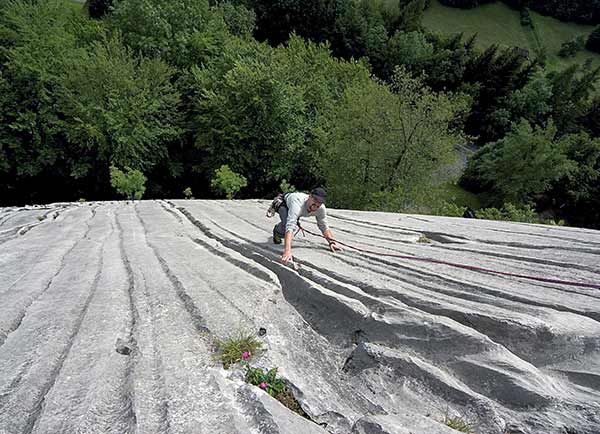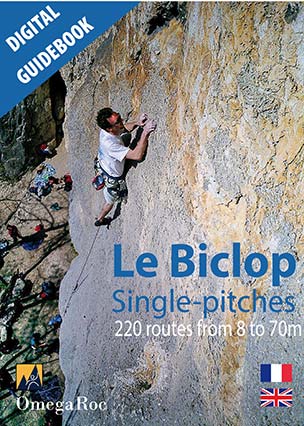
Climbing in Haute-Savoie
Haute-Savoie region includes a very large number of climbing sites.
For sport climbing, cliffs are scattered across all the massifs of the region, leaving the plains relatively bare.
For multi-pitch routes, the Arve Valley is a must-visit area as well as the Aravis and Aiguilles Rouges massifs.
We are not talking about mountaineering climbing here, hence we’re not referring to the famous Mont Blanc massif, although it often serves as a backdrop. We are therefore limiting ourselves to the cliffs of Haute-Savoie accessible without special equipment, and that’s already a lot! Today, it takes nearly a dozen climbing guidebooks, more or less voluminous, to cover the cliffs of the region.
The digital guidebooks available on OmegaRoc
During 2024, most of Gilles Brunot’s guidebooks* will be available on the OmegaRoc web app.
The profit from the sales of these guidebooks is donated to the EKIPROC association, which funds a significant amount of the equipment used to bolt or re-bolt routes in Haute-Savoie.
* In collaboration with Georges Brenas for the Giffre, Risse, Foron guidebook
Le Biclop – The single-pitches
See the guidebook on the OmegaRoc app
As its name indicates, the digital guidebook “Le Biclop – The single-pitches”, focuses on the first 50 metres of the iconic cliff near Annecy. With routes drawn on photos, it is the perfect tool to navigate among the more than 200 routes and link-ups.
Le Biclop has been climbed for nearly a century, and the starts of many routes are polished, which is generally not the case once you get past the first few metres. This is why it’s worth climbing long pitches, to continue on beautiful, grippy rock and enjoy a magnificent view of the lake once you get above the treeline.
The overall profile of the crag is vertical, but you will also find slabs and slight overhangs. The climbing is technical, often on small holds (crimps and many ‘’gouttes d’eau’’) with some slopers as well.
GIFFRE, RISSE, FORON
See the guidebook on the OmegaRoc app
This guide is the digital version of the Giffre, Risse, Foron guidebook, with the exception of a few sites that the author has decided not to include due to their limited interest.
It includes 900 single-pitch routes and nearly 80 multi-pitch routes spread across 27 sites in the Giffre and Risse valleys north of Cluses, and in the Morzine region.
While most of the cliffs featured are sport crags (between one and three pitches), you will also find some cliffs with bolted multi-pitch routes.
The main cliffs included in this guidebook are: Anthon, Chapelle Saint-Grat, Le Cruz, Le Foron, Le Suet et Le Tuet.
You can purchase the complete guidebook or individual cliffs separately.
VALLEE DE L’ARVE – THE ARVE VALLEY
See the guidebook on the OmegaRoc app
This guidebook is the bible of the Arve Valley. It presents most of the sport crags and multi-pitch routes in the valley, between Cluses and Les Contamines-Montjoie. Predominantly on limestone cliffs (with some gneiss cliffs on the side of Les Contamines) you’ll find varied climbing, both in styles and levels.
With 900 sport routes and 200 multi-pitch routes, there’s something for everyone: from single-pitch routes to much taller cliffs, and even some very adventurous sectors (only the most classic routes are detailed here).
The main cliffs in the valley are:
Crags : Balmette et Superbalmette, Bionnassay, Cascade de Doran, La Duchère, Le Clis, La Frasse, Sous les glaciers
Multi-pitch cliffs: Pointe d’Ayère, Balme, La Croix de Fer, La Maladière, Tête Louis-Philippe, Tours d’Areu, Les Vuardes.
You can purchase the complete guidebook or individual cliffs separately.
BORNES – ARAVIS
See the guidebook on the OmegaRoc app
This digital guidebook combines the two volumes of the Bornes – Aravis guides. Only a few less interesting sites have intentionally been excluded.
It covers the sites within the triangle formed by Cluses – La Roche-sur-Foron – Ugine, meaning the Bargy, Aravis, and Bornes massifs.
Featuring 250 multi-pitch routes and 23 sport climbing crags (1000 single pitches), the Bornes – Aravis guide is the most “mountainous” of Gilles Brunot’s three guidebooks.
Most of the sites are at high elevation and overlook the valley, providing exceptional open panoramas.
The main cliffs of the region are::
Crags : La Colombière, Le Maquis, Malsaire, Le Rocher des Aravis, La Forclaz
Multi-pitch cliffs : La dalle de la Rosière, Le Jallouvre, Rocher de Leschaux, La Mamule , La Paroi de Gramusset, Le Petit Bargy, La Pointe Percée, Pointe Dzérat, Le Sappey
Coming in April 2024
BORNES – ARAVIS / Volumes 1 and 2
These guidebooks present all the sites within the triangle Cluses – La Roche-sur-Foron – Ugine, which means the massifs of Bargy, Aravis, and Bornes. You will find sport crags, of course, but also numerous multi-pitch cliffs. In total, nearly 1200 routes spread across 64 sites.



The quality of Gilles Brunot’s guidebooks
During the preparation of the guidebooks, nearly all routes has been climbed to provide reliable and detailed information.
Thus, for almost every route:
– For each single-pitch route, in addition to the grade, length, and a comment, you will also find the number of quickdraws needed, the type of effort (bouldery, endurance, or power endurance), the route’s interest level, and a comment.
– For multi-pitch routes, the grade (max and oblig.) of each pitch is indicated, along with the number of quickdraws needed for most “sport” routes, the gear for trad routes, a comment, and, if applicable, information to know before climbing the route.
– The height of most abseils and numerous belays are provided.
Most of the multi-pitch routes are drawn on photos, as well as some single-pitch sites. The hand-drawn illustrations of other sites are clear and very precise.
For each site, in addition to GPS guidance to the parking lot, access is systematically explained with very detailed text and diagrams… it’s hard to get lost.
When to climb in Haute-Savoie?
Thanks to varied altitudes and aspects, and in winter, greatly aided by increasingly mild temperatures, it’s possible to climb all year round.
In spring, you will probably choose sunny cliffs at lower altitudes to avoid snow.
In summer, shaded sites or those at higher altitudes are preferred, but beware (or enjoy) the breezes that blow on the large cliffs as soon as the sun appears. They cool the air from the second or third pitch onwards.
In autumn, anything is possible. However, as temperatures drop and low clouds and fog invade the plains and low valleys, it’s necessary to gain some altitude to stay above the cloud layer (which is generally below 800 to 1200 m). Thus, sometimes in autumn or winter, it’s possible to climb in a t-shirt in the sun while freezing fog persists much lower in the valley, and you even have a clear sky above a superb sea of clouds!
Note: Haute-Savoie is a very rainy region, so drying time for different cliffs is a factor to consider.


The rock and climbing styles
With over 200 sport crags, you can find nearly every possible climbing style, hence describing a predominant style is a difficult task. Most cliffs are limestone, but in the Chamonix Valley and around Saint-Gervais, you can also find gneiss and granite. Climbing here is mainly on crimps (Servoz, La Duchère) and/or on friction (Dalles du Chapeau and de L’Arveyron) with some cracks typical for these rock types.
Limestone comes in all its forms except for tufas, which are extremely rare in the area. The predominant trend, however, is vertical or slightly overhanging rock with sloppers (sometimes with holes), requiring generally technical and tiring climbing (Ablon, Le Suet, Le Cruz). There are also some beautiful water-grooved slabs (La Frasse, La Colombière, La dalle du Tuet, La Rosière, Le Sappey).
In the multi-pitch routes, cliffs are often vertical and exposed, on compact limestone for difficult routes or more sculpted rock and cracks for more accessible routes. Many accessible routes follow more low-angle faces favouring grassy areas.
The environnement
Many sites are located in the forest. It’s pleasant in the summer, but it doesn’t offer much of a view, and only the climber can enjoy it, although they often have other things on their mind. But, as you gain altitude, the alpine cliffs fit perfectly into the postcard landscape, completed with the tinkling of bells and panoramic views of glaciers and towering mountains.
To learn much more
You will find all this information and much more, cliff by cliff, on Gilles Brunot’s website escalade-74.com under the “Falaises et cartes” tab. A thorough work that reflects the precision of his guidebooks. In French only.

It happened in Haute-Savoie…
South-west pillar at the Croix de fer cliff: Immerse yourself in the atmosphere of this accessible route.
The great classic Arête du doigt at Pointe Percée (Aravis massif)
La Duchère cliff : single pitches or multi pitch routes. Gneiss for everyone’s pleasure! (In french)
Délit de fuite at the Pointe Centrale du Sapey (Sapey central peak) : Sun and dream limestone.
Explore the crags in the neighborhood
Here are some digital guidebooks for climbing in the surroundings areas.
To see all the guidebooks available on the OmegaRoc app: The OmegaRoc guidebooks







